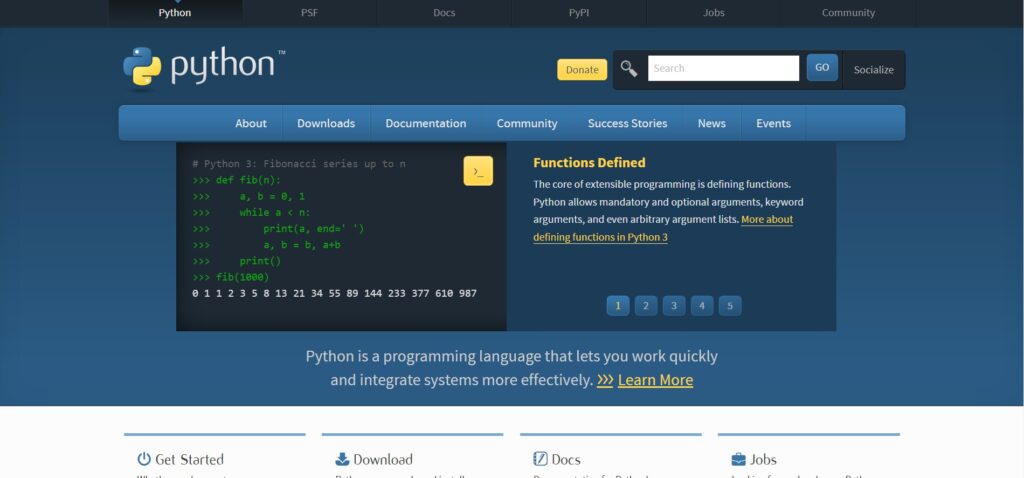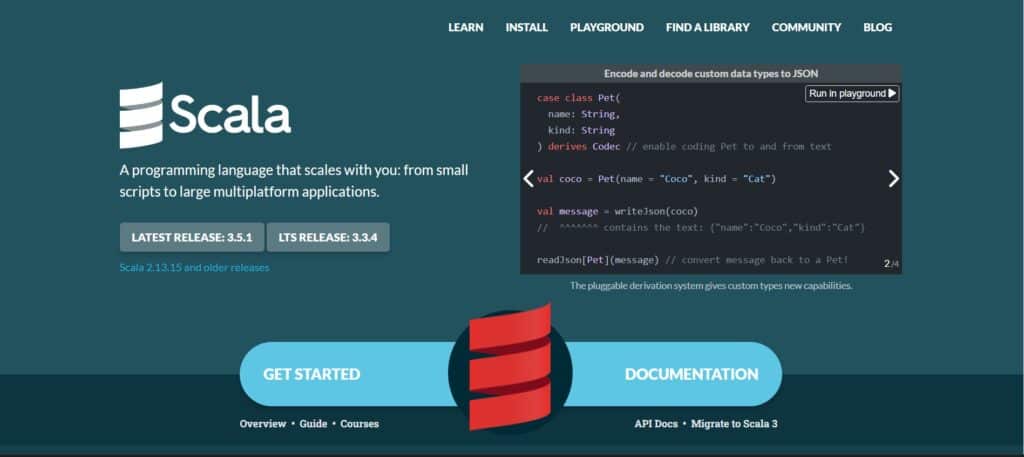TOP 10 popular AI Programming Languages
Selecting the right programming language is essential for developers looking to innovate and excel in this field.
These 10 popular AI programming languages i have carefully selected offer powerful features and accessible resources, enabling both newcomers and seasoned professionals to explore the vast potential of AI without financial barriers.
By leveraging these languages, you can effectively turn your AI ideas into reality and stay ahead in the competitive tech landscape.
1. Python
Python has firmly established itself as one of the top AI programming languages, largely due to its simplicity, versatility, and strong community support. This programming language is particularly favoured by data scientists, machine learning engineers, and developers for a variety of reasons.
Main Features of Python
- Readability and Simplicity: Python’s syntax is clear and straightforward, making it accessible for beginners while still powerful enough for experts. This readability is essential when working on complex AI projects.
- Rich Ecosystem of Libraries: Python boasts an extensive selection of libraries and frameworks tailored for AI, such as TensorFlow, Keras, and PyTorch. These tools allow developers to implement advanced algorithms and models with ease.
- Strong Community Support: The vast community around Python means that there are abundant resources, tutorials, and forums available. Developers can easily find help or collaborate with others in the field.
- Versatility: Python is not limited to AI; it can be used for web development, data analysis, automation, and more. This versatility allows developers to integrate AI applications seamlessly into various platforms.
- Integration Capabilities: Python can easily interface with other languages like C, C++, and Java, facilitating the integration of AI solutions into existing systems and applications.
Use Cases for Python in AI
Python is used across various sectors, showcasing its adaptability and effectiveness in solving real-world problems. Some prominent use cases include:
- Natural Language Processing (NLP): Python libraries like NLTK and spaCy allow for effective text processing and analysis, enabling applications such as chatbots and sentiment analysis.
- Computer Vision: With libraries like OpenCV and scikit-image, Python is instrumental in image processing tasks, from facial recognition systems to object detection.
- Data Analysis and Visualization: Python’s Pandas and Matplotlib libraries provide powerful tools for data manipulation and visualisation, critical for making data-driven decisions in AI projects.
- Machine Learning and Deep Learning: Frameworks such as TensorFlow and PyTorch allow developers to build sophisticated machine learning models with relative ease, making Python a preferred choice for AI practitioners.
Pricing and Plans
Python itself is an open-source language and is free to use.
Official Website
Visit the official website: Python.org.
2. R
Renowned for its statistical capabilities and data visualisation, R is an invaluable tool in the realm of artificial intelligence.
Main Features of R
- Statistical Computing: R was specifically designed for statistical analysis and data visualisation. Its extensive statistical packages make it a powerful tool for data modelling and hypothesis testing.
- Rich Ecosystem of Packages: The Comprehensive R Archive Network (CRAN) hosts thousands of packages that extend R’s capabilities, particularly in machine learning and data manipulation. Libraries like caret, randomForest, and ggplot2 are indispensable for AI practitioners.
- Data Visualisation: R excels in creating high-quality graphics and visualisations. With packages like ggplot2 and plotly, users can create sophisticated and interactive plots to explore data and present findings effectively.
- Integration with Other Languages: R can integrate seamlessly with other programming languages such as Python and C++, allowing for versatile application in complex projects and easy incorporation into existing codebases.
- Community Support: R has a vibrant community of users who contribute to forums, blogs, and tutorials, providing ample resources for beginners and advanced users alike.
Use Cases for R in AI
R’s statistical prowess and data manipulation capabilities lend themselves to various AI applications. Some notable use cases include:
- Predictive Analytics: R is commonly used for building predictive models in various fields, such as finance and healthcare, utilising its strong statistical tools and machine learning algorithms.
- Data Mining: The language’s robust data manipulation features allow for efficient data mining, making it a go-to choice for exploratory data analysis.
- Bioinformatics: R is widely used in bioinformatics for statistical analysis and visualisation of complex biological data, helping researchers draw insights from genomic data.
- Social Media Analytics: R is effective in analysing social media data, enabling sentiment analysis and trend detection through its extensive data processing capabilities.
For a deeper understanding of how R can be applied across different domains, check out our sections on AI Strategy and AI Applications.
Getting Started with R
Pricing and Plans
R is open-source software, which means it is free to use.
Official Website
For more information about R, visit the official website: R Project.
3. Java
Java is celebrated for its portability, scalability, and rich ecosystem. Its ability to run on any device with a Java Virtual Machine (JVM) makes it a favoured choice among developers for artificial intelligence projects.
Main Features of Java
- Platform Independence: Java’s “write once, run anywhere” philosophy allows developers to create applications that can be run on any platform that supports the JVM. This feature is especially beneficial for AI applications deployed in diverse environments.
- Rich Libraries and Frameworks: Java boasts a plethora of libraries and frameworks tailored for AI and machine learning. Libraries such as Deeplearning4j, Weka, and MOA provide robust tools for building intelligent applications.
- Object-Oriented Programming: Java is an object-oriented language, which facilitates code reusability and modularity. This paradigm is particularly useful in complex AI projects, allowing developers to create easily maintainable codebases.
- Strong Community Support: With a vast community of developers, Java users benefit from abundant resources, including forums, tutorials, and documentation, ensuring assistance is readily available for troubleshooting and best practices.
- Performance and Efficiency: Java’s performance is optimised through Just-In-Time (JIT) compilation and garbage collection, making it suitable for high-performance AI applications that require efficient resource management.
Use Cases for Java in AI
Java’s features and capabilities lend themselves well to various AI applications. Some notable use cases include:
- Natural Language Processing (NLP): Java’s extensive libraries, such as Apache OpenNLP, are employed in building NLP applications for tasks like sentiment analysis, text classification, and chatbot development.
- Machine Learning: Java frameworks like Weka and Deeplearning4j enable developers to implement machine learning algorithms for predictive analytics, classification, and clustering tasks.
- Robotics: Java is often used in robotics programming, providing the tools necessary for controlling robotic systems and processing sensory data.
- Big Data Technologies: Java is integral to big data frameworks such as Apache Hadoop and Apache Spark, facilitating the processing of large datasets used in AI applications.
Pricing and Plans
Java itself is free and open-source, making it accessible to developers. However, some tools and platforms that enhance Java’s capabilities may have associated costs:
- IntelliJ IDEA: This popular Java IDE offers a free community edition, while the Ultimate edition starts at around $499 per year, providing advanced features for professional development.
Official Website
For more information about Java, visit the official website: Java.
4. Julia
Designed specifically for high-performance numerical analysis and computational science, Julia combines the ease of use of dynamic programming languages with the performance of statically-typed languages.
Main Features of Julia
- High Performance: Julia’s Just-In-Time (JIT) compilation allows it to execute code as quickly as C, making it suitable for performance-critical applications. This speed is especially beneficial for AI algorithms that require extensive computations.
- Multiple Dispatch: Julia’s multiple dispatch system enables method selection based on the types of all function arguments, enhancing code efficiency and allowing for more intuitive programming. This feature is advantageous when developing complex AI models that require flexibility.
- Built-in Support for Parallelism: Julia offers native support for parallel and distributed computing, allowing developers to easily scale their applications across multiple cores or machines. This is crucial for training large-scale AI models.
- Rich Ecosystem: Julia has a growing ecosystem of packages tailored for various AI applications. Libraries such as Flux.jl for deep learning, and MLJ.jl for machine learning, provide comprehensive tools for AI development.
- Interoperability: Julia can easily interface with other programming languages such as Python, C, and R, allowing developers to leverage existing code and libraries. This feature facilitates collaboration and integration with other AI frameworks.
Use Cases for Julia in AI
Julia’s powerful features make it an excellent choice for various AI applications. Some notable use cases include:
- Machine Learning: Julia’s MLJ.jl package offers a unified interface for machine learning, making it easy to implement algorithms for classification, regression, and clustering.
- Deep Learning: With libraries like Flux.jl, Julia provides the tools needed for building and training neural networks, enabling developers to create advanced AI models.
- Data Science: Julia’s speed and ease of use make it a popular choice among data scientists for data manipulation, analysis, and visualisation tasks.
- Scientific Computing: Julia is widely used in scientific research for simulations and modelling, where performance is critical for handling large datasets and complex calculations.
Pricing and Plans
Julia itself is free and open-source, making it accessible to anyone interested in AI development. The community actively contributes to its development, ensuring a wide range of tools and resources are available at no cost.
Official Website
For more information about Julia, visit the official website: Julia.
6. JavaScript
Originally designed for client-side scripting, JavaScript has evolved into a robust language capable of handling various AI tasks, especially in web-based environments.
Main Features of JavaScript
- Ubiquitous Presence: JavaScript is the backbone of web development, allowing developers to create interactive web applications. Its widespread use means that many AI tools and libraries are now being developed with JavaScript, enabling seamless integration with existing web technologies.
- Rich Ecosystem of Libraries: JavaScript boasts a plethora of libraries and frameworks tailored for AI and machine learning. Libraries such as TensorFlow.js and Brain.js enable developers to implement machine learning algorithms directly in the browser or on Node.js.
- Asynchronous Programming: JavaScript’s event-driven architecture supports asynchronous programming, which is crucial for handling multiple tasks simultaneously—an essential requirement in AI applications, especially for real-time data processing.
- Cross-Platform Compatibility: JavaScript runs on all major browsers, making it a perfect choice for deploying AI applications that need to be accessible from any device. This feature is particularly useful for creating AI-powered web applications that serve a wide audience.
- Community Support: With a vast community of developers, JavaScript benefits from extensive resources, tutorials, and forums, making it easier for newcomers to learn and integrate AI into their projects.
Use Cases for JavaScript in AI
JavaScript’s flexibility makes it suitable for various AI applications. Some notable use cases include:
- Web-Based Machine Learning: Using libraries like TensorFlow.js, developers can create machine learning models that run directly in the browser, enabling real-time inference without the need for server-side computation.
- Natural Language Processing (NLP): JavaScript is increasingly used for NLP applications, allowing developers to create chatbots and virtual assistants that operate seamlessly on websites.
- Data Visualization: JavaScript libraries such as D3.js enable developers to create interactive visualisations for data analysis, which is essential for interpreting AI model results.
- Computer Vision: With tools like tracking.js and p5.js, JavaScript can be employed for image and video analysis, making it possible to implement computer vision applications directly in web browsers.
Pricing and Plans
JavaScript is a free, open-source programming language, making it accessible to all. Developers can leverage various free libraries and frameworks for AI without any licensing costs.
- Frameworks and Libraries: Most popular JavaScript libraries, such as TensorFlow.js and Brain.js, are also free to use, offering extensive capabilities for implementing AI solutions in web applications.
Official Website
For more information about JavaScript, visit the official website: JavaScript
6. C++
C++ is a powerful, high-performance programming language that has secured its place as one of the top 10 popular AI programming languages. Known for its efficiency and control over system resources, C++ is widely used in AI applications that require significant computational power and optimised performance.
Main Features of C++
- High Performance: C++ is renowned for its speed and efficiency, making it an ideal choice for AI applications that demand high-performance computing, such as real-time data processing and complex simulations.
- Object-Oriented Programming: C++ supports object-oriented programming (OOP) principles, allowing developers to create modular and reusable code. This feature facilitates the development of complex AI systems by promoting code organization and maintenance.
- Memory Management: C++ offers fine-grained control over memory allocation and deallocation, enabling developers to optimize performance and resource usage. This control is crucial for building AI algorithms that process large datasets efficiently.
- Rich Library Ecosystem: The C++ ecosystem includes several libraries specifically designed for AI and machine learning, such as OpenCV for computer vision, TensorFlow for deep learning, and Dlib for machine learning and data analysis.
- Cross-Platform Compatibility: C++ can be compiled to run on various operating systems, making it a versatile choice for developers aiming to deploy AI applications across different platforms.
Use Cases for C++ in AI
C++ is employed in a variety of AI applications, showcasing its capabilities and performance advantages. Some notable use cases include:
- Computer Vision: C++ is extensively used in computer vision applications, thanks to libraries like OpenCV, which provide powerful tools for image processing and analysis.
- Robotics: Many robotics systems rely on C++ for controlling hardware and implementing AI algorithms, enabling real-time processing and decision-making capabilities.
- Game Development: In the gaming industry, C++ is often used for AI-driven character behaviour and environment interactions, allowing for dynamic and immersive gaming experiences.
- Simulation and Modelling: C++ is used in simulation frameworks that require high performance and real-time processing, essential for testing AI algorithms in virtual environments.
To explore more about how C++ is transforming various sectors, check our sections on AI Applications and AI Tools.
Getting Started with C++
To begin your C++ programming journey, visit the official C++ website, which offers comprehensive resources, tutorials, and documentation for developers of all levels.
Pricing and Plans
C++ is an open-source programming language, available for free. Developers can utilize various libraries and frameworks without incurring any licensing fees.
- Libraries: Popular C++ libraries for AI, such as OpenCV and TensorFlow, are also available for free, allowing developers to harness advanced capabilities for their projects.
For additional insights into AI tools and resources, check out our AI Products section.
Official Website
For more information about C++, visit the official website: C++.
7. Lisp
Renowned for its unique syntax and powerful features, Lisp has been a favourite among AI researchers and developers for decades.
Main Features of Lisp
- Symbolic Computation: Lisp excels in symbolic computation, which is essential for many AI tasks such as natural language processing and theorem proving. Its ability to manipulate symbols makes it particularly effective for AI applications.
- Dynamic Typing: Lisp supports dynamic typing, allowing developers to write flexible and adaptable code. This feature is beneficial in AI research, where algorithms may need to evolve based on new data and insights.
- Garbage Collection: Lisp’s built-in garbage collection mechanism helps manage memory automatically, freeing developers from manual memory management and enabling them to focus on algorithm development.
- Macros and Metaprogramming: One of Lisp’s standout features is its powerful macro system, which allows developers to extend the language and create domain-specific languages. This capability can streamline AI development by enabling tailored solutions for specific problems.
- Interactive Development: Lisp environments often provide interactive programming capabilities, allowing developers to test and modify their code in real time. This feature is particularly useful in AI experimentation and prototyping.
Use Cases for Lisp in AI
Lisp has been used in various AI applications, demonstrating its strengths and versatility. Some notable use cases include:
- Natural Language Processing (NLP): Lisp’s symbolic processing capabilities make it a suitable choice for NLP tasks, where understanding and manipulating human language is crucial.
- Expert Systems: Many early expert systems were built using Lisp, thanks to its support for symbolic reasoning and easy manipulation of complex data structures.
- Machine Learning: Although less common today, Lisp has been used in machine learning research, particularly in the development of early neural networks and evolutionary algorithms.
- Robotics: Lisp is sometimes used in robotic systems for controlling behaviours and decision-making processes, benefiting from its ability to handle complex algorithms.
For more insights into how Lisp and other languages are shaping the AI landscape, visit our sections on AI Tools and AI Strategy.
Pricing and Plans
Lisp is an open-source programming language, available for free. Developers can access various implementations and libraries without incurring any costs.
- Implementations: Popular Lisp implementations such as SBCL (Steel Bank Common Lisp) and ECL (Embeddable Common Lisp) are freely available, allowing developers to choose the one that best fits their needs.
Official Website
Visit the official website: Lisp.
8. Haskell
Haskell, a purely functional programming language, is gaining traction as one of the top 10 popular AI programming languages.
Known for its strong static typing and expressive syntax, Haskell offers unique advantages that make it well-suited for various AI applications.
Main Features of Haskell
- Purely Functional: Haskell is a purely functional language, meaning that functions have no side effects. This feature simplifies reasoning about code, making it easier to maintain and debug, which is crucial in complex AI systems.
- Strong Static Typing: Haskell’s strong static typing system catches errors at compile-time rather than run-time. This capability enhances code reliability and safety, essential qualities for developing robust AI algorithms.
- Lazy Evaluation: Haskell employs lazy evaluation, allowing expressions to be evaluated only when needed. This feature enables developers to work with potentially infinite data structures and supports more efficient memory usage.
- Type Inference: Haskell’s type inference system reduces the amount of type information that developers need to explicitly declare. This feature promotes cleaner code and allows for faster prototyping.
- Rich Ecosystem: Haskell boasts a rich ecosystem of libraries and frameworks, including those specifically designed for AI, such as the HLearn library for machine learning and HMatrix for numerical computations.
Use Cases for Haskell in AI
Haskell has been effectively used in various AI applications, showcasing its strengths in functional programming. Some notable use cases include:
- Machine Learning: Haskell’s strong type system and abstractions facilitate the development of machine learning algorithms, allowing for clear implementations of complex models.
- Natural Language Processing (NLP): Haskell’s expressive syntax and ability to handle symbolic computations make it a suitable choice for NLP tasks, particularly in research settings.
- Data Analysis: With libraries like HMatrix and Frames, Haskell is well-equipped for data analysis and manipulation, which are essential in training AI models.
- Automated Reasoning: Haskell’s functional nature and powerful type system lend themselves to automated reasoning applications, enabling sophisticated reasoning about logical propositions.
Pricing and Plans
Haskell is an open-source programming language, available for free. Developers can download and use the GHC (Glasgow Haskell Compiler) and a plethora of libraries without any cost.
- Community Support: The Haskell community offers numerous resources, including forums and chat rooms, where you can seek help and advice on your projects.
Official Website
For additional information about Haskell, visit the official website: Haskell.
9. Prolog
Prolog is particularly known for its strong capabilities in symbolic reasoning and knowledge representation.
Main Features of Prolog
- Declarative Paradigm: Unlike imperative programming languages, Prolog is a declarative language. This means that developers specify what the program should accomplish rather than how to achieve it. This abstraction simplifies the coding process for complex AI algorithms.
- Pattern Matching: Prolog excels at pattern matching, which is fundamental for tasks such as natural language processing and database querying. Its built-in backtracking mechanism allows for efficient exploration of possible solutions.
- Facts and Rules: In Prolog, knowledge is represented using facts and rules. Facts are basic assertions about data, while rules define relationships between facts. This structure makes Prolog particularly well-suited for knowledge-based systems.
- Inference Engine: Prolog has a powerful inference engine that can derive conclusions from the provided facts and rules. This capability enables the implementation of sophisticated reasoning tasks in AI applications.
- Rich Ecosystem: Prolog has a variety of libraries and frameworks that facilitate AI development, including those for machine learning, natural language processing, and expert systems.
Use Cases for Prolog in AI
Prolog’s unique features make it particularly effective for specific AI applications. Some notable use cases include:
- Expert Systems: Prolog is widely used for developing expert systems that mimic the decision-making abilities of human experts. Its rule-based approach allows for clear representation of knowledge and reasoning processes.
- Natural Language Processing (NLP): Prolog’s pattern matching and symbolic reasoning capabilities make it a strong choice for NLP tasks, such as parsing and understanding human language.
- Theorem Proving: Prolog is employed in automated theorem proving, where it can be used to verify mathematical propositions based on defined axioms and rules.
- Game Development: Prolog’s ability to represent complex rules and scenarios makes it suitable for developing intelligent agents in games, enabling them to reason and make decisions based on game states.
Pricing and Plans
Prolog is primarily open-source, making it available for free. Users can download SWI-Prolog and access numerous libraries without incurring any costs.
- Community Support: The Prolog community is active, offering forums and chat rooms for assistance, making it easy to find help with your projects.
Official Website
For further information about Prolog, visit the official website: SWI-Prolog.
10. Scala
Scala has gained popularity in the AI community for its scalability and expressiveness, making it one of the top popular AI programming languages.
Main Features of Scala
- Hybrid Programming Model: Scala seamlessly integrates object-oriented and functional programming, allowing developers to choose the best paradigm for their specific tasks. This flexibility is especially beneficial in AI, where different approaches may be needed for various problems.
- Strong Type System: Scala’s strong static type system helps catch errors at compile time, leading to more robust and maintainable code. This feature is particularly advantageous when developing complex AI systems.
- Concurrency Support: Scala’s support for concurrent programming through actors and futures enables developers to build scalable AI applications that can efficiently manage multiple tasks simultaneously.
- Interoperability with Java: Scala runs on the Java Virtual Machine (JVM), allowing for easy integration with existing Java libraries and frameworks. This interoperability makes it a practical choice for teams working with Java-based technology stacks.
- Rich Ecosystem: Scala boasts a rich ecosystem of libraries and frameworks, including Apache Spark, a popular tool for large-scale data processing, making it ideal for AI and machine learning projects.
Use Cases for Scala in AI
Scala’s powerful features lend themselves to a variety of AI applications, including:
- Machine Learning: With libraries like Spark MLlib, Scala is a robust choice for developing scalable machine learning models that can handle large datasets efficiently.
- Data Processing: Scala’s functional programming capabilities simplify data manipulation tasks, making it easier to preprocess and analyze data for AI projects.
- Natural Language Processing (NLP): Scala’s libraries, such as Breeze and Stanford NLP, provide tools for text analysis, enabling the development of sophisticated NLP applications.
- Big Data Applications: Scala is widely used in big data processing with frameworks like Apache Spark, which is essential for training AI models on large datasets.
Getting Started with Scala
To dive into Scala programming, you can find extensive resources, documentation, and tutorials on the official Scala website. The website offers guides for beginners, library references, and links to community forums.
Pricing and Plans
Scala is an open-source language, freely available for developers. You can download it and start using it without any costs.
Official Website
For further information about Scala, visit the official website: Scala.
Choosing from the top 10 popular AI programming languages allows developers to harness the power of AI while keeping costs manageable.
These languages provide the tools needed to experiment and create impactful solutions, regardless of your experience level. Embrace these programming options and unlock the potential to drive innovation in your projects.





















